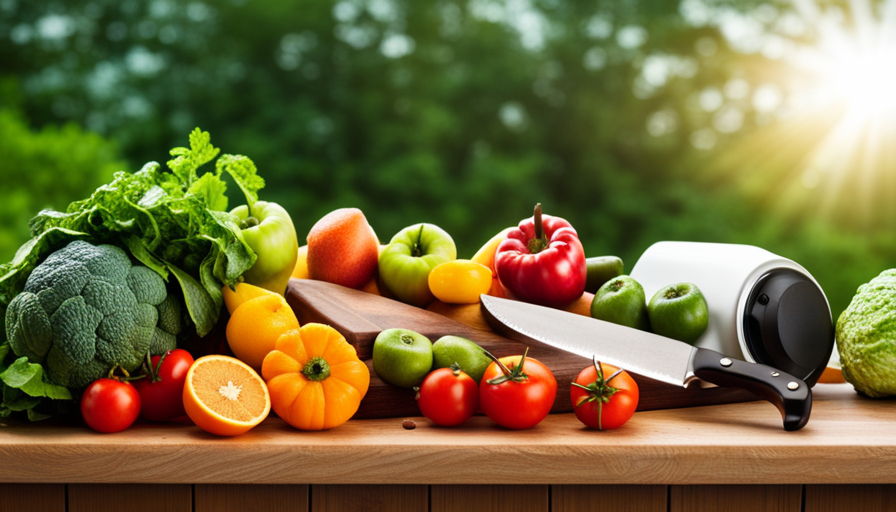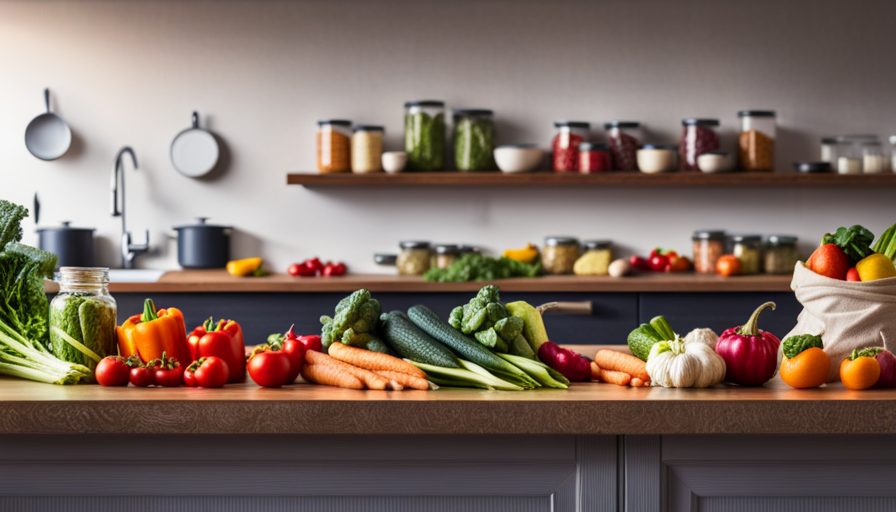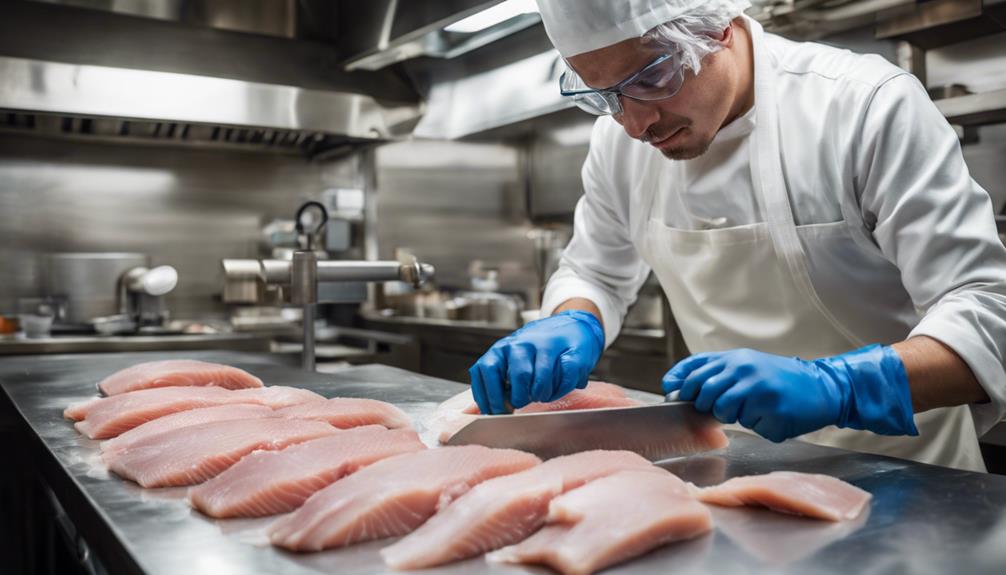Are you prepared to begin a journey towards vibrant health and wellness? Welcome to the realm of raw food! This exciting movement not only delights the taste buds but also rejuvenates your body from within.
In this article, I will guide you through the ins and outs of raw food, providing you with all the necessary tools and knowledge to succeed on your raw food journey.
Raw food is a revolutionary approach to eating that involves consuming uncooked, unprocessed, and plant-based foods. By harnessing the power of nature’s bounty, raw food enthusiasts experience increased energy levels, improved digestion, and a glowing complexion.
But don’t worry, you won’t be munching on plain carrots and celery sticks all day! I will show you how to create delicious and satisfying meals that will leave your taste buds dancing with delight.
So, let’s dive into the world of raw food together and discover the countless benefits, easy recipes, and practical tips for incorporating this lifestyle into your daily routine.
Get ready to nourish your body, delight your senses, and unleash your inner health warrior with raw food!
Key Takeaways
- Raw food is a revolutionary approach to eating that involves consuming uncooked, unprocessed, and plant-based foods.
- Incorporating raw food into your diet can support weight loss and overall health.
- Proper storage is crucial to maintain freshness and prevent spoilage of raw food.
- Creating a meal plan for the week can help you stay on track with your raw food diet goals.
Understanding the Basics of Raw Food
Ready to dive into the world of raw food? Let’s start by understanding the basics and uncovering the incredible benefits of this nourishing lifestyle.
Understanding raw food nutrition is essential in order to make informed choices about what to include in our diets. Raw food is food that hasn’t been cooked or heated above 118 degrees Fahrenheit (48 degrees Celsius), as heating at higher temperatures can destroy some of the nutrients. This means that raw food is rich in vitamins, minerals, and enzymes that are beneficial for our bodies.
One of the main benefits of incorporating raw food into your diet is weight loss. Raw food is naturally low in calories and high in fiber, which can help you feel full and satisfied while consuming fewer calories. Additionally, raw food is often nutrient-dense, meaning you get more nutrients per calorie compared to processed or cooked foods. This can support weight loss and overall health.
Transitioning into the next section about the benefits of incorporating raw food into your diet, it’s important to note that raw food isn’t only beneficial for weight loss, but it can also improve digestion, boost energy levels, and enhance overall well-being.
Benefits of Incorporating Raw Food into Your Diet
Embrace the incredible advantages of adding fresh, unprocessed ingredients to your meals and watch as your health and vitality soar. Incorporating raw food into your diet brings numerous health benefits and opens up a world of delicious and nutritious raw food recipes. Here are five reasons why you should consider embracing raw food:
-
Boosted Nutrient Intake: Raw foods are packed with essential vitamins, minerals, and enzymes that can be lost during cooking. By consuming raw fruits, vegetables, and nuts, you ensure that you get the maximum nutritional value from these foods.
-
Improved Digestion: Raw foods are rich in fiber, which aids digestion and promotes regular bowel movements. They also contain live enzymes that assist in breaking down food and assimilating nutrients, resulting in improved digestion and nutrient absorption.
-
Enhanced Energy Levels: Raw food is abundant in natural sugars, fibers, and antioxidants, providing sustained energy throughout the day. Unlike processed foods that can cause energy crashes, raw foods provide a steady stream of vitality.
-
Weight Management: Including raw food in your diet can help with weight management due to its high fiber content and low calorie density. Raw fruits and vegetables are filling and satisfying, making it easier to maintain a healthy weight.
-
Radiant Skin and Hair: Raw foods are rich in antioxidants, vitamins, and minerals that nourish your skin and hair from the inside out. Consuming raw food can result in a glowing complexion and lustrous hair.
By incorporating raw food into your diet, you can experience these incredible health benefits and more. Now, let’s explore how to stock up on raw food essentials without compromising on taste or variety.
Stocking Up on Raw Food Essentials
Feeling adventurous? Take a leap into the world of uncooked ingredients and discover the essential items you need to stock up on for your raw culinary journey.
When it comes to raw food, proper storage is crucial to maintain freshness and prevent spoilage. Invest in airtight containers or mason jars to keep your nuts, seeds, and dried fruits in optimal condition. Additionally, make sure to have a good supply of fresh produce, such as leafy greens, fruits, and vegetables. These can be stored in the refrigerator to extend their shelf life.
When shopping for raw food, opt for organic and locally sourced options whenever possible. This ensures that you’re getting the highest quality ingredients, free from pesticides and other harmful chemicals. Don’t forget to include some superfoods in your shopping list, like chia seeds, hemp hearts, and spirulina. These nutrient-dense powerhouses will add an extra boost to your raw meals.
Now that you’re well-stocked, it’s time to move on to the next section about easy and delicious raw food recipes. Get ready to tantalize your taste buds with these mouthwatering creations!
Easy and Delicious Raw Food Recipes
Make your taste buds dance with delight as you explore a variety of simple and mouthwatering recipes that celebrate the vibrant flavors of uncooked ingredients. Here are three quick raw food snacks and raw food desserts that’ll satisfy your cravings while keeping you healthy and energized:
-
Raw Energy Balls: These bite-sized treats are packed with nutrients and can be made in just minutes. Mix together dates, nuts, and your favorite superfood powders like cacao or maca. Roll into balls and refrigerate for a delicious on-the-go snack.
-
Zucchini Noodles with Pesto: Swap out traditional pasta for zucchini noodles to create a refreshing and light dish. Top with homemade pesto made from fresh basil, pine nuts, garlic, and olive oil. It’s a guilt-free alternative that still satisfies your pasta cravings.
-
Raw Chocolate Avocado Mousse: Indulge in a rich and creamy dessert without any guilt. Blend together ripe avocados, raw cacao powder, maple syrup, and a pinch of sea salt. This decadent mousse isn’t only delicious but also full of healthy fats and antioxidants.
With these easy and delicious raw food recipes, you can enjoy nutritious meals and snacks that are bursting with flavor.
Now, let’s move on to some tips for meal planning and preparing raw food without losing any of the nutritional value.
Tips for Meal Planning and Preparing Raw Food
Discover how to effortlessly incorporate nourishing and vibrant ingredients into your meals with these simple tips for planning and preparing delicious, uncooked dishes. Meal prepping is key when it comes to incorporating raw food into your diet. By taking the time to plan and prepare your meals ahead of time, you can ensure that you always have healthy options on hand.
One helpful strategy is to create a meal plan for the week. This involves deciding what raw dishes you want to make and then creating a shopping list based on those recipes. By having a plan in place, you can avoid any last-minute trips to the grocery store and stay on track with your raw food diet goals.
When it comes to preparing raw food, it’s important to keep in mind the nutritional benefits. Raw fruits, vegetables, nuts, and seeds are packed with vitamins, minerals, and enzymes that can support overall health. By eating these foods in their raw state, you can maximize their nutritional content and enjoy their natural flavors.
To help you visualize the process of planning and preparing raw meals, here is a table that outlines a sample meal plan for a week:
| Day | Breakfast | Lunch | Dinner |
|---|---|---|---|
| Monday | Green smoothie | Raw salad | Zucchini noodles |
| Tuesday | Chia pudding | Veggie wrap | Raw sushi rolls |
| Wednesday | Fresh fruit salad | Raw soup | Raw tacos |
| Thursday | Overnight oats | Raw spring rolls | Cauliflower rice |
| Friday | Acai bowl | Raw sandwich | Raw pad Thai |
By following a meal plan like this, you can ensure that you are getting a variety of raw foods throughout the week. This will keep your taste buds satisfied and your body nourished. So, now that you know how to meal prep and the nutritional benefits of raw food, let’s dive into exploring different types of raw food diets.
Exploring Different Types of Raw Food Diets
When it comes to meal planning and preparing raw food, there are plenty of tips to help make the process easier and more enjoyable. However, it’s also important to explore the different types of raw food diets that are available. This can help you find the approach that works best for your health goals and lifestyle.
Here are four different types of raw food diets that you might consider:
-
Raw Vegan Diet: This diet consists of fruits, vegetables, nuts, and seeds in their raw, unprocessed form. It’s a popular choice for those who want to follow a plant-based diet.
-
Raw Vegetarian Diet: Similar to the raw vegan diet, this diet includes raw fruits, vegetables, nuts, and seeds. However, some raw vegetarians might also include raw dairy products, such as raw milk or cheese.
-
Raw Paleo Diet: This diet focuses on consuming raw, unprocessed animal products, such as raw meat, fish, and eggs. It’s based on the belief that our ancestors primarily ate raw foods.
-
Raw Food for Weight Loss: This type of raw food diet is specifically designed for weight loss and typically involves consuming low-calorie, nutrient-dense raw foods.
By exploring these different types of raw food diets, you can find the one that suits your needs and preferences best. Now, let’s move on to the next section and discuss how to overcome challenges and stay motivated on your raw food journey.
Overcoming Challenges and Staying Motivated on Your Raw Food Journey
Facing challenges and staying motivated on your journey towards a raw food lifestyle can be tough, but with determination and support, you can overcome any obstacles that come your way.
One of the key challenges people face when transitioning to a raw food diet is the lack of variety and convenience. It can be difficult to find raw food options when dining out or attending social gatherings. However, there are ways to stay motivated and make the raw food lifestyle work in any situation.
To stay motivated, it’s important to set realistic goals and celebrate small victories along the way. Surround yourself with a supportive community of like-minded individuals who can offer guidance and encouragement. Additionally, finding creative ways to incorporate raw foods into your meals can help keep things interesting. Experiment with different recipes and ingredients to discover new flavors and textures.
Overcoming challenges may require some planning and preparation. When dining out, research restaurants that offer raw food options or contact the establishment in advance to inquire about accommodating your dietary needs. If attending a social event, bring your own raw food dishes to share or eat beforehand so you’re not tempted by unhealthy options.
Incorporating raw food into social settings and dining out doesn’t have to be daunting. By staying motivated and overcoming challenges, you can continue on your raw food journey with confidence and success. Transitioning to a raw food lifestyle isn’t a step, but a continuous process of growth and discovery.
Incorporating Raw Food into Social Settings and Dining Out
To truly enjoy social settings and dining out while maintaining your raw food lifestyle, you’ll need to find creative ways to incorporate nutrient-rich, unprocessed options into your meals. Here are some tips to help you navigate dining out options and socializing with non-raw food eaters:
-
Research restaurants beforehand: Look for places that offer fresh salads, veggie wraps, or raw food options on their menu. This way, you can be prepared and make an informed choice when dining out.
-
Communicate with your server: Let them know about your dietary preferences and ask if they can accommodate your needs. Many restaurants are willing to make adjustments or create custom dishes to suit your raw food lifestyle.
-
Bring a dish to share: If you’re attending a social gathering or potluck, bring a raw food dish that you can enjoy and share with others. This way, you’ll have something delicious to eat and introduce others to the benefits of raw food.
Incorporating raw food into social settings and dining out can be challenging at times, but with a little planning and communication, it’s definitely possible. By being proactive and creative, you can enjoy delicious raw food meals while still connecting with friends and family.
Next, let’s explore some common misconceptions about raw food and debunking myths.
Common Misconceptions about Raw Food and Debunking Myths
Now that we’ve explored how to incorporate raw food into social settings and dining out, let’s address some common misconceptions about raw food and debunk these myths.
There are often misconceptions that raw food is tasteless, boring, and lacking in nutrients. However, this couldn’t be further from the truth. Raw food can be incredibly flavorful and exciting, with a wide variety of textures and flavors to explore. Additionally, raw food is packed with essential nutrients, enzymes, and antioxidants that are beneficial for our health.
One common myth is that raw food isn’t as filling as cooked food. However, raw food can be just as satisfying and filling, especially when you incorporate healthy fats, such as avocados and nuts, into your meals.
Another misconception is that raw food is time-consuming and difficult to prepare. While some recipes may require more preparation, there are plenty of quick and easy raw food options that can be whipped up in no time.
By debunking these myths, we can better understand the health benefits and enjoy the variety that a raw food lifestyle offers. So, let’s dive into the next section and explore the resources and support available for your raw food journey.
Resources and Support for Your Raw Food Lifestyle
Looking for guidance and assistance on your journey towards a vibrant and nourishing lifestyle? Discover the abundance of resources and support available to help you thrive in your raw food adventure.
-
Online communities: Joining a raw food community can provide you with invaluable support and a sense of belonging. Websites like Raw Food Talk and Raw Food Rehab offer forums, recipes, and advice from experienced raw food enthusiasts. These communities are great places to ask questions, share successes, and connect with like-minded individuals.
-
Books and cookbooks: There’s a wealth of information available in print to assist you on your raw food journey. Books like ‘The Raw Food Detox Diet’ by Natalia Rose and ‘Raw Food Made Easy for 1 or 2 People’ by Jennifer Cornbleet provide valuable insights, tips, and recipes for beginners. Cookbooks such as ‘Everyday Raw’ by Matthew Kenney and ‘Raw Food Real World’ by Sarma Melngailis offer a wide range of delicious and creative raw food recipes.
-
Workshops and classes: If you prefer hands-on learning, attending raw food workshops and classes can be a great way to gain knowledge and skills. Many cities offer workshops on topics like raw food preparation, juicing, and dehydrating. These events often provide opportunities to meet others who share your passion for raw food and can offer additional support and inspiration.
By utilizing these resources for beginners and finding a raw food community, you can enhance your raw food journey and increase your chances of long-term success. Remember, everyone’s path is unique, so find what works best for you and enjoy the incredible benefits of a raw food lifestyle.
Frequently Asked Questions
Can I still get all the necessary nutrients from a raw food diet?
Yes, it’s possible to obtain all the necessary nutrients from a raw food diet. Raw food recipes, such as salads, smoothies, and sprouted grains, can provide a wide range of vitamins, minerals, and antioxidants.
The benefits of a raw food diet include increased energy, improved digestion, and weight management. However, it’s important to ensure a balanced intake of nutrients, including protein, calcium, and vitamin B12, which may require careful planning and supplementation.
Consulting a healthcare professional or registered dietitian is advisable.
How can I ensure food safety when consuming raw foods?
When it comes to ensuring food safety while consuming raw foods, there are some important guidelines to follow. First, make sure to thoroughly wash all fruits and vegetables before eating them.
Additionally, it’s crucial to handle raw meat and seafood separately from other foods to prevent cross-contamination.
Another key step is to store perishable raw foods in the refrigerator to minimize the growth of harmful bacteria.
By following these precautions, you can reduce potential risks and enjoy your raw food diet safely. Remember, better safe than sorry!
Is it possible to gain weight on a raw food diet?
Yes, it’s possible to gain weight on a raw food diet. While raw food diets are often associated with weight loss, it ultimately depends on the individual’s food choices and portion sizes. To gain weight, focus on consuming calorie-dense raw foods such as nuts, seeds, avocados, and coconut. Additionally, proper meal planning is crucial to ensure you’re getting enough nutrients and energy from your raw food meals.
Can I eat raw food while pregnant or breastfeeding?
Yes, it’s possible to eat raw food while pregnant or breastfeeding, but it’s important to follow raw food safety tips. Make sure to thoroughly wash all fruits and vegetables before consuming them. It’s also advisable to avoid certain raw foods that may pose a higher risk of foodborne illnesses, such as raw seafood and unpasteurized dairy products. However, a raw food diet during pregnancy can offer benefits like increased nutrient intake and improved digestion. Always consult with your healthcare provider before making any dietary changes.
How can I deal with cravings for cooked or processed foods while on a raw food diet?
When dealing with cravings for cooked or processed foods on a raw food diet, I find it helpful to explore cooking alternatives that still align with the principles of raw food. One interesting statistic is that there’s been a significant increase in the popularity of raw food recipes, with a 200% rise in online searches over the past five years. This shows that more people are finding creative ways to satisfy their cravings while staying true to their raw food lifestyle.
How Can I Safely Prepare Raw Food to Prevent Contamination from Pathogens?
When preparing raw food, it’s essential to take precautions to eliminate raw meat pathogenesis surfaces. Use separate cutting boards for raw meats and other foods, wash your hands and surfaces frequently, and use a food thermometer to ensure proper cooking temperatures are reached to prevent contamination from pathogens.
Conclusion
In conclusion, incorporating raw food into your diet can have numerous benefits for your health and overall well-being.
One interesting statistic to consider is that a study published in the Journal of Nutrition found that individuals who followed a raw food diet experienced significant decreases in total cholesterol levels, blood pressure, and body weight.
This visual representation of the impact of raw food on health can serve as motivation to continue on your raw food journey.
Remember to stock up on essentials, try out delicious recipes, and seek support and resources to help you along the way.
Stay committed and enjoy the many benefits of a raw food lifestyle!










